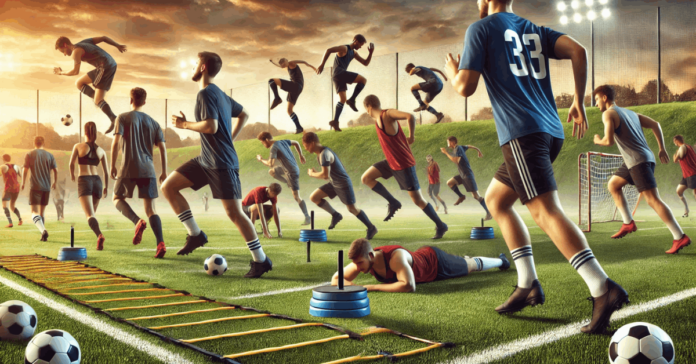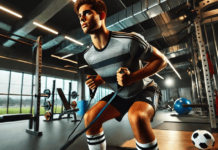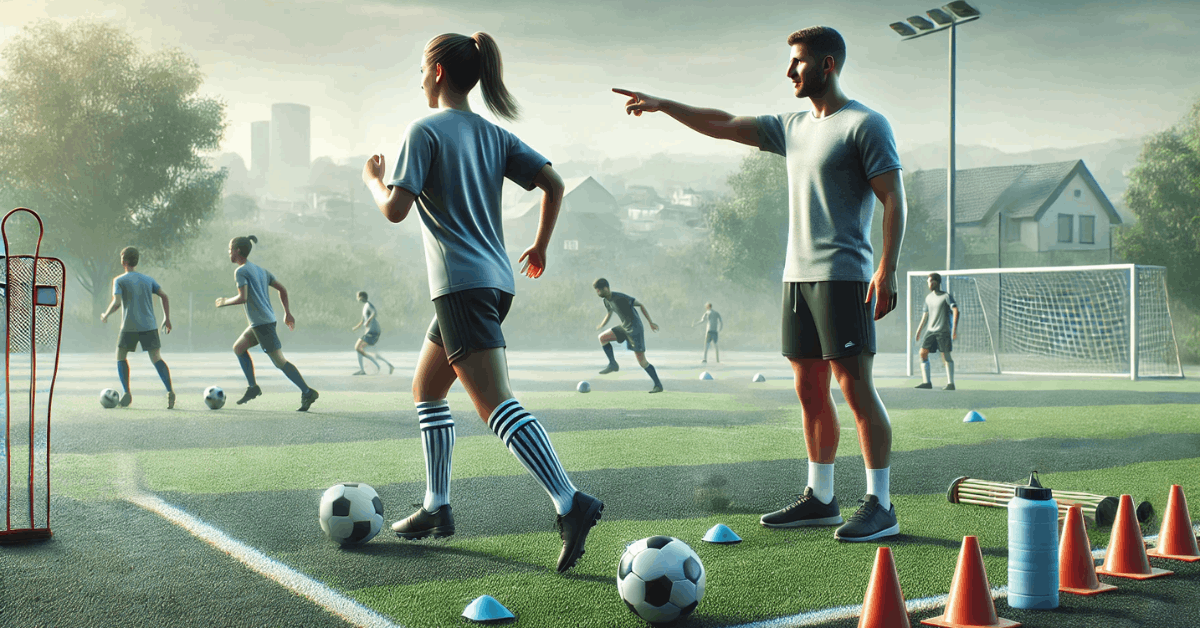
Ever thought about walking onto the soccer field, filled with confidence?
That’s what effective soccer workouts can do! For soccer enthusiasts worldwide, focusing on top exercises is more than just improving athletic skills; it’s about elevating every part of the game.
These workouts prepare players for explosive sprints and the stamina to last a full 90 minutes. This guide equips you with key exercises tailored for soccer players, aiming to enhance both physical prowess and tactical knowledge. Let’s get started!
Warm-Up Routine for Soccer Workouts
Starting a soccer workout begins with an effective warm-up to prepare the body for the high demands of the sport.
This initial phase is key to boosting performance and minimizing injury risks. Here’s how players worldwide can initiate their training:
Dynamic Stretches
Initiate with dynamic stretches to wake up the muscles. Opt for movements that resemble those used in a soccer game.
Leg swings and arm circles, positioned with feet shoulder-width apart, ready the joints for activity and improve flexibility.
Cardiovascular Warm-up Drills
Proceed with quick-paced running or side shuffles to elevate the heart rate. These drills are crucial for enhancing blood circulation to the muscles, making sure players are prepared for the match.
Activation Exercises for Key Muscle Groups
Conclude the warm-up by focusing on essential muscle groups such as the quadriceps, hamstrings, glutes, and calves, which are pivotal in soccer.
Incorporate strength exercises like squats or lunges to boost stability and power, ensuring players step onto the pitch ready and confident.
Speed Training
Speed and reaction time are essential skills for any soccer player. Quick footwork is vital for gaining or shielding the ball.
Top professional players like Cristiano Ronaldo, Lionel Messi, and Kylian Mbappe are all remarkable sprinters.
Reaching Cristiano’s speed of 24 mph isn’t necessary, but as a striker, running at full speed while dribbling will keep defenders on high alert. Defenders need speed to catch offensive players and prevent them from breaking through.
Uphill Sprints
Speed hill training builds speed effectively. This training resembles sprinting while lifting weights, with the gradient making the sprint challenging.
This resisted exercise combines speed and strength training, offering benefits like building stamina, increasing ankle strength, and boosting explosiveness. For coaches, these workouts also promote mental toughness and goal-setting behavior.
How to Do Uphill Sprints
- Start at the base in a solid 2.0 stance.
- Explode out of the stance and sprint uphill at top speed for 20-30 yards.
- Walk back down and cool down for about 90 seconds.
- Complete 4-8 repetitions, with 90-120 seconds of rest between each.
Sled Pushes
The sled push, or prowler press, is a sled loaded with weights. This exercise offers a comprehensive full-body strength and speed workout, challenging physical fitness.
Sled pushes are versatile, can be customized for various training effects, and are great for gym exercises for soccer players. They rev up metabolism and elevate heart and lung activity without typical muscle strain.
Proper sled pushes engage lower and upper body muscles, including the chest, shoulders, abdominals, quads, glutes, and calves.
- Start with around 30-40% of your maximum load if you’re new to the sled.
- Use a lower grip on the bars to mimic a natural sprinting position.
- Push the sled for 30-40 yards with 100% effort.
- Take a 2-minute rest before sprinting the sled back.
- Repeat this sequence 8-10 times, ensuring adequate rest between each sprint.
Agility Training for Soccer Players
Soccer demands more than just sprinting speed. The game requires sudden starts, quick turns, and instantaneous changes in direction. Agility is the ability to change direction rapidly without losing coordination, strength, balance, or ball control.
1-on-1 Change of Direction Drill
This drill enhances reaction time, footwork, and quick direction changes. It’s simple yet effective, adding fun to warm-ups.
Setup and Execution:
- Arrange 2 parallel lines using five cones spaced 6 yards apart.
- Place a 4-yard gap between the first four cones and a 10-yard gap between the fourth and fifth cones.
- Divide the team into two groups. Each group stands behind the starting cones in a line. Assign one group as leaders and the other as followers.
- The first leader sprints forward, with the first follower running immediately to stay close.
- The leader makes a sudden 180-degree turn at any of the three cones and heads back towards the starting line, then makes another turn to sprint to the finishing cone.
- The follower mirrors the leader’s turns, staying as close as possible.
- After the second turn, both players sprint to the finish line.
- The next pairs of players begin after the first players finish.
After finishing, players rejoin the line, switching roles so that the leader becomes the follower. Rotate players to ensure everyone faces all teammates.
In/Out Agility Ladder Drill
An agility ladder is a cost-effective tool that enhances agility, endurance, coordination, and cardiovascular fitness.
This foldable ladder can be used almost anywhere—on the pitch, at the gym, or even in your bedroom. If you don’t have an agility ladder, create one with tape.
Execution:
- Roll out the ladder on a flat surface.
- Stand at one end with feet hip-width apart.
- Hop forward into the first square.
- Push off immediately, spreading both feet outside the ladder.
- Hop into the next square with both feet, then push off again.
- Repeat through the entire ladder.
The in/out drill is just one exercise with an agility ladder. Refer to a comprehensive guide on soccer speed and agility drills for more exercises.
These agility workouts are designed to improve performance for soccer players worldwide, enhancing skills necessary for all positions on the field.
Leg Workouts for Soccer Players
Training strength for soccer starts with the legs. Although soccer engages the entire body, the legs do most of the work. Running, tackling, blocking opponents, and making passes or shots all require excellent lower-body strength.
Effectiveness in these actions depends heavily on leg strength. The best soccer workouts focus on building strong legs and increasing explosive power, speed, endurance, and overall performance.
Box Jumps
Box jumps are excellent for soccer workouts at home, offering numerous benefits for physical fitness.
This exercise strengthens the legs, promotes balance, and helps develop a stronger core and powerful arms, making it an effective tool for soccer players.
How to Perform Box Jumps for Soccer Training:
- Place a box or set of boxes two feet in front at a challenging but manageable height.
- Stand with feet shoulder-width apart in a half-squat position. Align the head with the spine and extend the arms behind the glutes.
- Jump using energy from the legs and hips.
- Perform 4-5 sets of 6-8 repetitions each.
Jump Squats
Jump squats are another effective training exercise for soccer that requires no equipment.
This high-intensity workout targets leg muscles, glutes, and lower abs. When performed correctly, jump squats enhance physical performance, balance, and mobility.
How to Perform Jump Squats for Soccer Training:
- Stand straight with feet shoulder-width apart.
- Place hands by the side, roll back shoulders, push the chest up, lift the chin, and look ahead.
- Bend knees and push hips back to a sitting position, ensuring knees don’t go past toes.
- Squat down with palms together.
- Spring up from the squat position, throwing hands down.
- Land gently and return to the squat position.
- Complete 3 sets per session with 15 reps each.
These workouts focus on enhancing leg strength, which is crucial for soccer performance worldwide.
Soccer Workouts for Endurance
To maintain peak performance in soccer, you need the ability to sprint, dodge, and jump consistently throughout the match.
Endurance workouts are essential to building a strong, resilient system that keeps you at your best until the final whistle. These exercises enhance recovery, focus, and decision-making, training your heart to deliver oxygen efficiently to your muscles.
Burpee Pull-Ups
Burpee pull-ups, favored by top players like Ronaldo, are a comprehensive conditioning drill. They target multiple muscle groups, including the upper body, core, and lower body, providing a robust cardiovascular workout.
Each repetition strengthens the chest, abs, arms, quads, hamstrings, and glutes, boosting overall strength and endurance.
How to Perform Burpee Pull-Ups:
- Stand under a high bar, feet shoulder-width apart.
- Bend down, place your hands on the floor ahead of your toes, and jump your legs back into a push-up position.
- Perform a push-up, then lift your hips rapidly into a squat position.
- Stand up, jump to grab the bar, and perform a pull-up.
- Return to standing position and repeat.
- Aim for 5-10 push-ups and pull-ups per set.
HIIT on Treadmill
When outdoor workouts are disrupted, a treadmill is an excellent alternative. High-intensity interval Training (HIIT) on a treadmill is particularly effective for building soccer-specific endurance.
These exercises push your fast-twitch muscle fibers to their limits, stimulating muscle growth and preparing you for future physical demands.
How to Perform HIIT on a Treadmill:
- Start with a 5-10 minute warm-up, walking or jogging.
- Increase speed to 80-85% of maximum heart rate and run for 1 minute.
- Follow with a 1-2 minute recovery period at a comfortable walking or jogging pace.
- Repeat the 1-minute sprint and 1-2 minute recovery cycle for 20-30 minutes.
- Conclude with a 5-minute cool-down, walking or jogging gradually.
These workouts are designed to keep you fit and improve your game, ensuring you maintain high-performance levels throughout the match, regardless of your location worldwide.
Flexibility Training
Flexibility training is essential for soccer players to maintain mobility and reduce injury risks. A thorough stretching session is necessary to loosen muscles used in weight training and gameplay.
Incorporating yoga into your routine enhances flexibility and mental focus, which are important for high-performance sports. Yoga training for soccer players includes:
- Warrior Pose: Strengthens legs, opens hips, and improves balance.
- Downward Dog: Stretches hamstrings, calves, and back, enhancing flexibility needed for maintaining a squat position.
- Pigeon Pose: Opens hip flexors and glutes, areas often tightened by repetitive soccer movements.
Foam rolling is another key tool for improving flexibility and aiding recovery. Using a foam roller helps stretch and loosen muscles, making it an excellent practice for enhancing overall flexibility.
This technique involves applying pressure to specific muscle groups to release tightness and increase range of motion. This is particularly beneficial after engaging in strenuous activities like soccer.
Regular foam rolling can lead to greater elasticity in muscles and connective tissue, facilitating easier movement and reducing the risk of injuries.
Conclusion
The drills mentioned provide optimal training. Incorporating these workouts into your routine will enhance fitness and performance.
Stay consistent, push your limits, and track progress. By dedicating time and effort, you’ll see improvements in stamina, agility, and game skills.
Commitment is key. Keep pushing and enjoy becoming a better soccer player worldwide.






